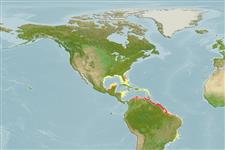Environment: milieu / climate zone / depth range / distribution range
Ecología
marino; agua dulce; salobre demersal; pH range: 7.0 - ? ; dH range: 10 - ?; rango de profundidad 1 - 40 m (Ref. 5217). Tropical; 23°C - 26°C (Ref. 2060)
Western Atlantic: Gulf of Paria to the Amazon River in Brazil.
Tamaño / Peso / Age
Maturity: Lm ? range ? - ? cm
Max length : 29.3 cm TL macho / no sexado; (Ref. 71685); common length : 25.0 cm TL macho / no sexado; (Ref. 5217)
Espinas dorsales (total) : 0; Radios blandos dorsales (total) : 11 - 12; Espinas anales: 0; Radios blandos anales: 11. Body except for snout, pectoral base and caudal peduncle covered with prickles; teeth fused into plates, two plates on each jaw; nostril with two openings; body dark green dorsally with six transverse black bars, white ventrally; fins dusky green or dark brown (Ref. 13608).
Solitary or in groups of 2 or 3 individuals but never in schools (Ref. 35237). Inhabits shallow inshore waters usually on soft bottoms. Frequently found in freshwater (Ref. 13608). When threatened, it becomes inflated like a balloon, in order to ward off predators. Carnivorous, feeding mainly on mollusks which crushes with its powerful teeth (Ref. 35237). Of negligible commercial importance and usually not marketed (Ref. 5217).
Life cycle and mating behavior
Maturities | Reproducción | Spawnings | Egg(s) | Fecundities | Larva
Cervigón, F., R. Cipriani, W. Fischer, L. Garibaldi, M. Hendrickx, A.J. Lemus, R. Márquez, J.M. Poutiers, G. Robaina and B. Rodriguez, 1992. Fichas FAO de identificación de especies para los fines de la pesca. Guía de campo de las especies comerciales marinas y de aquas salobres de la costa septentrional de Sur América. FAO, Rome. 513 p. Preparado con el financiamento de la Comisión de Comunidades Europeas y de NORAD. (Ref. 5217)
IUCN Red List Status (Ref. 130435)
Threat to humans
Harmless
Human uses
Pesquerías: comercial; Acuario: Comercial
Herramientas
Special reports
Download XML
Fuentes de Internet
Estimates based on models
Preferred temperature (Ref.
123201): 25.6 - 28, mean 27.3 °C (based on 210 cells).
Phylogenetic diversity index (Ref.
82804): PD
50 = 0.7500 [Uniqueness, from 0.5 = low to 2.0 = high].
Bayesian length-weight: a=0.02512 (0.01608 - 0.03923), b=2.86 (2.74 - 2.98), in cm total length, based on LWR estimates for this species & (Sub)family-body (Ref.
93245).
Nivel trófico (Ref.
69278): 3.6 ±0.50 se; based on food items.
Resiliencia (Ref.
120179): Alto, población duplicada en un tiempo mínimo inferior a 15 meses (Preliminary K or Fecundity.).
Fishing Vulnerability (Ref.
59153): Low vulnerability (19 of 100).
